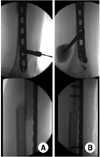Abstract
The minimally invasive plate osteosynthesis (MIPO) which is extensively performed, is very dependent on the indirect reduction technique to prevent the exposure of fracture sites. Indirect reduction with the use of the femoral distractor is a much more efficient technique to restore the length in the fracture of lower limbs. However, the femoral distractor cannot be used for fracture of upper limbs, and other instruments for indirect reduction have not yet been reported. Therefore, we introduce the novel indirect reduction technique with the use of the lumbar spreader for the MIPO of upper limbs.
Figures and Tables
References
1. Apivatthakakul T, Arpornchayanon O, Bavornratanavech S. Minimally invasive plate osteosynthesis (MIPO) of the humeral shaft fracture. Is it possible? A cadaveric study and preliminary report. Injury. 2005. 36:530–538.

2. Apivatthakakul T, Patiyasikan S, Luevitoonvechkit S. Danger zone for locking screw placement in minimally invasive plate osteosynthesis (MIPO) of humeral shaft fractures: a cadaveric study. Injury. 2010. 41:169–172.

3. Borg T, Larsson S, Lindsjö U. Percutaneous plating of distal tibial fractures Preliminary results in 21 patients. Injury. 2004. 35:608–614.
5. Clement H, Pichler W, Tesch NP, Heidari N, Grechenig W. Anatomical basis of the risk of radial nerve injury related to the technique of external fixation applied to the distal humerus. Surg Radiol Anat. 2010. 32:221–224.

6. Duncan SF, Weiland AJ. Minimally invasive reduction and osteosynthesis of articular fractures of the distal radius. Injury. 2001. 32:Suppl 1. SA14–SA24.

7. Kregor PJ. Distal femur fractures with complex articular involvement: management by articular exposure and submuscular fixation. Orthop Clin North Am. 2002. 33:153–175.
8. Oh CW, Oh JK, Jeon IH, et al. Minimally invasive percutaneous plate stabilization of proximal tibial fractures. J Korean Fract Soc. 2004. 17:224–229.





 PDF
PDF ePub
ePub Citation
Citation Print
Print





 XML Download
XML Download